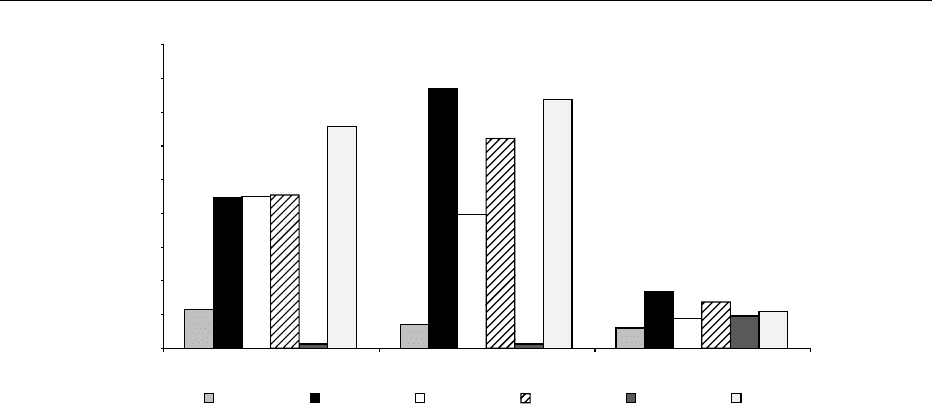Caballero B. (ed.) Encyclopaedia of Food Science, Food Technology and Nutrition. Ten-Volume Set
Подождите немного. Документ загружается.


transported in the blood to be metabolized by the
liver into fat constituents. In total, about 50% of the
energy of the fermented polyols is available to the
human body.
0006 Based on the above metabolic behavior, the calor-
ific value of polyols can approximately be calculated
(Table 3). However, depending upon the methodolo-
gies used, values vary over a wide range. Therefore,
and because many polyols are used in combination
with each other, a European Union Directive has laid
down an average calorific value of 2,4 kcal g
4
for all
polyols.
0007 Because of the reduced digestibility of polyols,
their intake level is recommended to be restricted to
40–50 g day
1
(adults) and 30 g day
1
for children in
order to avoid gastrointestinal discomfort. Higher
doses may cause an osmotic diarrhea or increased
flatulence due to slow absorption and extensive fer-
mentation, respectively, but tolerance levels improve
upon adaptation. On the other hand polyols are very
suitable for diabetics, because rapid glycemic or
insulinemic response is avoided. For the same
reason sorbitol and xylitol are often applied in
parenteral nutrition to provide a more controllable
carbohydrate energy source compared to glucose or
fructose.
0008 Concerning dental health, polyols have long been
known to have no adverse effect on teeth. This is due
to the fact that mouth bacteria are unable to ferment
polyols, thereby avoiding the production of enamel-
solubilizing acids. With the intraplaque pH telemetry
test, it was shown that eating polyol-based sweets did
not decrease the plaque pH below the critical value of
5.7. Additionally, for xylitol, there is ample proof of a
cariostatic effect. In several studies, of which the
Turku study (Finland) is most famous, the incorpor-
ation of xylitol in a normal diet was proved to reduce
the occurrence of dental carics. Most probably,
xylitol selectively discriminates against the growth
of Streptococcus mulans, the major organism in-
volved in dental caries. (See Dental Disease: Role of
Diet.)
Occurrence and Methods of Production
0009Polyols like sorbitol, mannitol, and xylitol have been
well known over the last 30 years due to their occur-
rence in a number of fruits, vegetables, and cereals.
Although they occur in nature, their concentration in
plant material is too low for a simple, economic
commercial extraction, as practiced with sucrose. A
more complicated process is therefore needed for the
production of sugar alcohols.
0010Several techniques have been described to produce
polyols but only a few of them are of industrial im-
portance. These are mainly based on catalytic hydro-
genation of easily accessible carbohydrates, e.g.,
dextrose, glucose syrups, maltose syrups, invert
sugar, isomaltulose, xylose, and lactose. These carbo-
hydrates are obtained either by hydrolysis or isomer-
ization of natural raw materials like starch, sucrose,
milk (whey), and straw (Figure 2).
0011The carbohydrate raw material is hydrogenated in
an aqueous solution at elevated temperatures (120–
190
C) and hydrogen pressure (20–200 bar) using an
activated nickel catalyst. Hydrogenation can be per-
formed either in a batch or a continuous process, and
results in the addition of hydrogen to the carbohy-
drate precursor. Hydrogen pressure, temperature, pH
value, and type of catalyst are the most important
parameters influencing reaction time and selectivity.
They have to be well adjusted to obtain a high-purity
product in high yield. Purity of the raw material is
also of importance in this respect. The hydrogenated
carbohydrate (polyol-containing) solution is sub-
sequently refined by filtration, carbon, and/or ion
exchange resin treatment to remove salts as well as
colored byproducts formed during hydrogenation.
0012Sorbitol and maltitol are available as aqncous solu-
tions and also as crystalline material. Mannitol, xyli-
tol, lactitol, and isomalt are available as crystalline
material. All crystalline polyols are produced by
crystallization, solidification, or spray-drying of an
aqueous solution at an appropriate concentration.
tbl0002 Table 2 Sweetness values of sugar alcohols
Compound Relative sweetness
Polyol
a
Xylitol 80–100
Sorbitol 50–60
Mannitol 50–60
Maltitol 80–90
Lactitol 30–40
Isomalt 40–50
Erythritol 60–70
Sucrose
a
100
a
10% in H
2
O: 20
C.
tbl0003 Table 3 Absorption characteristics of sugar alcohols
Polyol Absorbed from
the smallintestine
(%)
Excreted (%) Fermented
(%)
Calorific
value
(kcalg
1
)
Urine Feces
Xylitol 25–40 0 < 1 60–75 2.9
Sorbitol 15–20 0 < 1 80–85 2.6
Mannitol 15–20 15–20 < 1 80–85 1.9
Maltitol 45–60 0 < 1 40–55 3.2
Lactitol < 1 0 < 1 99 2.3
Isomalt 35–45 0 < 1 55–65 3.0
SUGAR ALCOHOLS 5667

Uses in Foods
0013 Substitution of sugars in food to achieve specific nu-
tritional objectives is not a new practice. Initially,
polyols like sorbitol and mannitol were used to
sweeten food for diabetics. To cope with sensorial
and technological requirements for noncariogenic
food, the range of polyols has been extended to
include products such as maltitol, xylitol, isomalt,
and lactitol.
0014 For the production of polyol-based foods, most
conventional types of food-manufacturing equipment
are used. However, manufacturing conditions (tem-
perature, vacuum, etc.) very often need to be adapted.
As some polyols are moderately hygroscopic, the
relative humidity of air during production and stor-
age conditions require careful control. It is also neces-
sary to assure good protection by careful wrapping
and/or packaging. When neccessary, sweetness of
polyol-based foods can be enhanced by adding the
neccessary amounts of intense sweetners like aspar-
tame, accsulphame K, cyclamate, and saccharin. (See
Sweeteners: Intensive.)
0015 In addition to the production of sugarless foods,
polyols, e.g., sorbitol, can also be used in convention-
ally sweetened food products in order to give specific
sensorial effects such as texture and reduced color.
There are also technological advantages such as
plasticity, workability, and shelf-life. In particular,
sorbitol is widely used for its humectancy power to
extend food products shelf-life.
0016The main uses of polyols in food products are
outlined below.
Sugar-Free Confectionery
0017This is the most important application field for
polyols.
Hard Confectionery
0018Hard confectionery is produced by boiling polyol
solutions or syrups to a very high dry-matter content
(98–99.4%) followed by cooling, molding, and wrap-
ping. The boiling temperature for such polyol confec-
tionery varies between 155 and 170
C depending
on the type of polyol. Severe vacuum conditions are
needed. With the exception of mannitol, all the
polyols can be used alone. However, for technical
and economical reasons very often combinations of
polyols are applied. It should be kept in mind that the
solubility of polyols strongly influences crystalliza-
tion and graining.
Soft and Chewable Confectionery
0019The main component in this application is a polyol
or a polyol blend (65–70% dry matter) which is
Maltitol syrupSorbitol syrup
Enzymatic hydrolysis Inversion Acidic hydrolysis Crystallization
Enzymatic
conversion
Invert sugarMaltose syrup
Dextrose/
glucose syrup
Xylose LactoseIsomaltulose
MaltitolSorbitol Mannitol Xylitol LactitolIsomalt
Hydrogenation/filtration/ion exchange/evaporation
Crystallization or solidification
Starch Sucrose Whey
Straw,
birch wood,
almond shells
etc.
fig0002 Figure 2 Commercial production of sugar alcohols. Reproduced from Sugar Alcohols, Encyclopaedia of Food Science, Food Technol-
ogy and Nutrition, Macrae R, Robinson RK and Sadler MJ (eds), 1993, Academic Press.
5668 SUGAR ALCOHOLS

presolubilized and cooked together with vegetable fat
(about 6%), emulsifier (about 0.8%), gelatin (about
1.4%), and other minor components, e.g., food-grade
acid, flavor, and color. After cooling, the mass is
formed and wrapped. Chewability of the sweets can
be obtained by acration of the cooked mass after
partial cooling using conventional acration tech-
niques such as pulling and continuous foaming.
Gums and Pastilles
0020 Maltitol syrups, alone or in combinations with either
lactitol or isomalt, are very suitable for the produc-
tion of gelatin gums. For some compositions it is
necessary to adapt the gelatin type and level as well
as the cooking conditions in order to obtain gum
properties equivalent to those obtained with conven-
tional sweetened gums.
0021 In pastilles a gum arabic/polyol ratio of 50/50 on a
dry-weight basis is advised. This composition is
cooked to 70–72% dry-matter content, molded in
starch, and dried to 90% dry matter. After demold-
ing, the gums are waxed. Maltitol syrups give good
pastilles with optimal shelf-life properties.
Tubletting
0022 Although all powdered polyols can be compressed on
rotary machines to give tablets, sorbitol is the most
common polyol used in this field.
0023 Powdered sorbitol has excellent flow properties for
tabletting. Good flowability is very important to pro-
vide a uniform tablet weight. Compared to other
directly compressible materials, powdered sorbitol
gives a high increase of tensile strength as a function
of compression force and is therefore very suitable for
direct compression. Due to their rather high hygro-
scopicity, sorbitol-based tablets should be protected
or stored under relatively dry conditions in order to
avoid softening due to moisture pick-up. The priabil-
ity of sorbitol tablets, even those compressed at low
pressure, is extremely low and is improved further by
storage at close to equilibrium relative humidity
(ERH). The overall performance of sorbitol powder
in tabletting depends upon different factors, such as
particle size and distribution, crystal morphology,
and compression conditions.
Chewing Gum
0024 The main components of sugar-free chewing gums
are gum base (25–30%), polyol powder as solid phase
(45–63%), and sorbitol or maltitol syrups as liquid
phase (10–30%). The solid phase can be sorbitol
powder, but more often a combination of sorbitol
and xylitol is used. The main advantages of xylitol
are its excellent cariostatic propertics, high sweetness,
and a pleasant cool taste due to its negative heat of
solution. Addition of a small quantity of glycerol
improves the plastifying properties; mannitol add-
ition prevents stickiness.
Chocolate
0025Total replacement of sucrose by polyol powder both
in bitter or milk chocolate is possible providing the
powder has an optimum purity, crystal morphology
and granulometry. A bitter chocolate consists of
40–50% cocoa mass, 40–50% polyol powder, and
5–10% cocoa butter.
0026Originally only sorbitol was used for sugar-free
chocolate. Recent trends are towards the use of
maltitol, isomalt, and lactitol.
Dragee Coating
0027Coating consists in covering cores, e.g., chewing
gum with a syrup which is close to its saturation
point, then inducing crystallization by evaporation.
Generally a lot of layers (40–50) are needed. The
temperature of polyol syrups, drying air, centers,
and core bed are very important processing param-
eters. Sorbitol is the most common sweetener for
sugarless coating, but maltitol, xylitol, isomalt, and
lactitol can also be used.
Bakery Products
0028Polyols can be used in bakery products due to their
specific properties which are lacking in many other
bulk sweeteners. The sugar alcohols contribute to
softness and storage capacity. They also regulate
moisture, taste, and sweetness. A combination of
polyols or a polyol combined with another sweetener
is preferred. If browning is too light, the baking tem-
perature can be raised or a small amount of fructose
can be added.
0029The baking industry uses crystalline sorbitol and
sorbitol solution in products for special dietary use. It
is also employed as a humectant to extend the shelf-
life of baked goods. The stability of baked products
can be improved by partial substitution of sucrose by
sorbitol, e.g., in cakes. Sorbitol is used in sponges and
cakes at between 5 and 8% of flour weight. In biscuits
and cream fillings it is used up to 10%. The freshness
of gingerbread is improved by adding only 5% sorb-
itol. It is also used to substitute sugar in classical
formulations for low-sugar products. (See Cakes:
Nature of Cakes.)
0030The use of the other polyols in bakery is rapidly
developing. The level of sugar replacement with these
sweeteners depends on the type of polyol and the
application objective. While, for some polyols, rather
SUGAR ALCOHOLS 5669

high usage levels can be achieved, e.g., for maltitol,
lactitol, and isomalt, for others, e.g., xylitol and man-
nitol, usage levels are generally low. These differences
are also related to the specific sensory and physico-
chemical properties of the polyols used. An important
contribution of the other polyols is, as for sorbitol,
the humectant properties which control the moisture
level in bakery products when stored for long periods.
In some cases, combinations of polyols can give inter-
esting complementary effects. The main applications
in the bakery field are cakes, biscuits, pastry, fillings,
and icings. In the last two products, xylitol and man-
nitol can be an asset due to their perceptible cooling
effect. (See Biscuits, Cookies, and Crackers: Nature of
the Products; Pastry Products: Types and Production.)
Other Areas of Application
0031 Polyols can also be used in sugarless jams and ice-
creams. Sorbitol-containing jams and preserves have
a clear taste and good texture. A sufficiently high
solids content can be obtained in order to inhibit
microbiological activity, thereby protecting the jams
against mold development. In order to avoid crystal-
lization during storage, the solubility of the polyol(s)
should be checked before formulating the food.
Erythritol
Chemical and Physical Properties
0032 Erythritol is a linear carbohydrate molecule of four
carbon atoms, each carrying one hydroxyl group. The
molecular structure is shown in Figure 3.
0033 Chemically, erythritol therefore belongs to the class
of monosaccharide polyols like sorbitol, mannitol,
xylitol, and glycerol. Erythritol is also a symmetrical
molecule and therefore it exists in only one form, the
mesoform. It forms anhydrous crystals with a moder-
ately sweet taste without off-taste or odors. The
powder has a transparent white brilliant appearance
and dissolves in water to give a colorless nonviscous
solution. Crystals melt at 122
C to form a colorless
and brilliant nonviscous melt.
0034Erythritol’s chemical properties are similar to those
of other polyols in that it has no reducing end groups
and thus has excellent heat- and acid-stability. It
differs in having a low solubility (37% ww at
25
C), a property which among these simple polyols
it shares with mannitol and isomalt. Heat of solution
is very low (181 J g
1
), a property shared with xyli-
tol. However, compared to the group of polyols pres-
ently used as sugar-replacers, erythritol has the lowest
molecular weight (122) which of course provides dif-
ferent properties, such as higher osmotic pressure and
lower water activity in solution. It has also a high
freezing-point depression and boiling-point elevation.
0035Compared to sucrose, erythritol has a sweetness
value of 60–70%. It has a clean, sweet taste, similar
to sucrose, a strong cooling effect, and shows many
synergies with intense sweeteners.
Occurrence and Methods of Production
0036Erythritol occurs in several foods at levels up to
0.13%. It is also present in human and animal tissue
and body fluids.
0037Briefly, erythritol is produced from wheat or corn
starch by enzymatic hydrolysis yielding glucose,
which is fermented by a safe and suitable yeast-like
fungi, Moniliella pollinis. Once erythritol is separated
from the sterilized fermentation broth, it is purified
by ion exchange resin, active carbon, ultrafiltration,
and crystallization. The final crystalline product,
which looks very similar to sugar, is more than
99.5% pure.
Uses in Foods
0038The main uses of erythritol in food products are
outlined below.
Tabletop Sweeteners
0039In tabletop applications, erythritol will be used at
levels up to 99.9% as a noncaloric, noncariogenic
carrier for intense sweeteners. In these applications,
the sensorial profile-modifying properties of erythri-
tol are of great importance, resulting in sweetness
synergy, improved mouth feel, and masking of off-
flavors. In addition, due to erythritol’s crystalline
structure and nonhygroscopic property, it offers
excellent flowability and stability as carrier.
Beverages
0040The synergies which erythritol shows when used in
combination with intense sweeteners are also very
useful in low-calorie beverages. Also, at use-levels of
3.5% or less, erythritol can mask certain off-flavors
in beverages like coffee, tea, and grapefruit juice.
HCOH
OHC
CH
2
OH
CH
2
OH
1,2,3,4-butanetetrol
H
fig0003 Figure 3 Molecular structure and chemical formula of erythritol.
5670 SUGAR ALCOHOLS

Chewing gum
0041 Good-quality noncaloric and noncariogenic chewing
gum can be formulated by using solely erythritol (use-
level up to 60%).
0042 Most of the sugar-free chewing gum produced
today has a tendency to become brittle and harder
during aging. This can be avoided and a sugar-free
chewing gum with softer texture, greater flexibility,
and improved shelf-life can be obtained by partial
replacement of the other sugar alcohol(s) using ery-
thritol.
Chocolate
0043 The use of erythritol in chocolate compositions
allows a dry conching process at high temperatures.
Due to the good heat-stability and low-moisture pick-
up of erythritol, it is even possible to work at higher
temperatures than traditionally used. This results in
enhanced flavor development.
0044 Erythritol-based chocolate is not only easy to
produce, it can also be considered a true ‘reduced-
calorie’ product.
Candies
0045 Sugar-free fudge with texture and shelf-life properties
equivalent to conventionally sweetened fudge can be
produced using erythritol (up to 40%) in combin-
ation with maltitol syrup (75% maltitol) to control
crystallization.
0046 Depending on the cooking temperature and
seeding level with erythritol, texture can be varied
from soft to hard. In hard candies, erythritol in its
crystalline form is used up to 50% for its cooling
effect as sherbet filling in die-formed hard candies,
or ‘sandwiched’ in between two layers in deposited
hard candies.
Fondant
0047 Using erythritol, it is possible to obtain sugar-free low-
calorie noncariogenic fondant with identical tech-
nical properties to classical products. Previously this
was impossible with the other low-calorie bulking
agents currently available. Pure erythritol induces
too high a crystallization, but 60% erythritol in com-
bination with maltitol syrup as a liquid phase helps to
control this phenomenon.
Lozenges
0048Research has shown that lactitol, crystalline malti-
tol, and erythritol are the only suitable materials to
produce a lozenge with a lower calorie content than
the conventional sugar-based lozenges, but which are
otherwise identical. In addition to the lower calorie
content and pronounced cooling effect, erythritol has
the added advantage over lactitol and crystalline mal-
titol of requiring a shorter drying time to obtain the
required texture at low residual moisture content.
Lozenges based on solely erythritol (up to 99%)
have excellent shelf-life properties, even when stored
under high humidity conditions.
Bakery (Pastry) Products
0049In fat cream, a very good texture is obtained with
erythritol at a use-level of 60% and a particle size
distribution below 300 mm. The manufacturing pro-
cess and shelf-life properties of the erythritol-based
fat cream are similar to those for conventional fat/
sucrose compositions. Erythritol has an effect of
masking the fatty mouth feel, giving a more refreshing
and attractive product. In addition, the calorie con-
tent of the composition is also reduced.
0050Reduction of calories in bakery products is particu-
larly difficult if only the sugar moiety is replaced.
Erythritol can reduce the caloric content by more
than 30% (dependent on the application) without
introducing undesirable side-effects. Additionally,
erythritol improves the shelf-life of bakery products.
Erythritol can be applied successfully in cookies, bis-
cuits, and cakes, where it improves baking stability
and shelf-life at an addition level of about 7%.
See also: Biscuits, Cookies, and Crackers: Nature of the
Products; Cakes: Nature of Cakes; Dental Disease: Role
of Diet; Isomalt; Pastry Products: Types and Production;
Sweeteners: Intensive
Further Reading
Tinfeld T and Mu
¨
hlemann HR (1978) Cariogenicity and
acidogenicity of food, confectionery and beverages.
Pharmacology and Therupeutics in Dentistry 3: 53–68.
Sheimin A and Maekinen KK (1975) Turku sugar studies-
I–XXI. Acta Odontologica Scandinavica 33 (suppl. 70):
1350.
SUGAR ALCOHOLS 5671

SUNFLOWER OIL
FJSa
´
nchez-Muniz and C Cuesta, Universidad
Complutense de Madrid, Madrid, Spain
Copyright 2003, Elsevier Science Ltd. All Rights Reserved.
Origin and Systematics
0001 The cultivated sunflower (Helianthus annus L.) is a
plant of the family Asteraceae (Compositae). The
term Helianthus is derived from the Greek helios,
meaning sun, and anthos, meaning flower. The prop-
erty of this flower ‘turning with the sun’ is clearly
expressed by the Spanish and French languages
when naming this plant.
0002 Hypothesis suggests that the wild H. annus of the
western USA became a camp-following weed of North
American Indians. In time it was introduced into the
central part of the country where it was domesticated
for use primarily as food. Archeological evidence
indicates the occurrence of heads and achenes of
domesticated types of sunflower as early as the first
millennium bc, and it has been suggested that culti-
vation began as early as 3000 bc. During the early
sixteenth century European visitors to America intro-
duced the sunflower to Europe, principally to Spain,
from where it spread throughout the continent. It was
grown initially as an ornamental plant and later for
food and medical purposes. The sunflower was de-
veloped as an important source of oil during the early
1800s in Russia. More recently, wild species have
been used in breeding programs. They have been
found useful in improving disease and insect resist-
ance of cultivars. The success of breeders (most from
the Former Soviet Union) in improving the oil content
of seeds from less than 30% to over 50% was a major
factor in the development of the sunflower as a major
world oilseed crop.
0003 The plant is generally grown to obtain oil, but meal
and hulls are also used or present potential uses (see
below).
World Sunflower Crop
0004 Sunflower ranks among the most important annual
field crops grown in the world for production of
edible oil. During the last decade, the total produc-
tion of sunflower has increased. Thus, in 1989–91 it
was estimated at about 22.3 million metric tons. In
1998–99 world production was about 26.7 million
tons (Table 1).
0005 Sunflower grows well in most regions of the world,
with significant production occurring in each of the
six crop-producing areas (Figure 1). Europe and
America (North, Central, and South America) are
the leading producers of sunflower seed, accounting
for about 50% of the world’s total production. In
Figure 1 production efficiency (kg ha
1
) in the six
world crop-producing areas is also presented. Recent
data show that the ex-USSR and Argentina are the
largest producers (Table 1). Other leading producers
are also presented in Table 1. However, because pro-
duction depends on cultivars and in many countries
efficiency is determined by the weather, the leading
order can change. For example, in Spain, one of the
leading producers, a high percentage of sunflower
comes from dry-ground cultivars, thus sunflower
seed production may change dramatically from
a wet year to a dry year (by about half a million
tons).
0006Although sunflower is grown primarily for its oil,
there is limited production of certain cultivars grown
for nonoilseed or confection purposes.
World Sunflower Oil Production
0007World edible oil and fats production has increased in
the last years with a total seed production in the year
2001 of 306.9 million metric tons. The sunflower oil
production since 1998 is presented in Table 1. World
production of sunflowerseed in the season 2002/03 is
currently forecast at 23.8 million metric tons. World
tbl0001Table 1 World sunflower crop and sunflower oil production
(Million Tons)
Country 1998 1999 2000 2001 Estimated2002
(as available at
6thof Sep 2002)
Ex-USSR 5.76 7.39 7.88 5.4 6.97
Central Europe 2.8 3.3 1.9 1.9 2.4
Argentina 7.2 5.7 3.1 3.7 3.9
EU-15 3.4 3.1 3.3 2.9 2.6
South Africa 0.5 0.6 0.8 0.8 0.9
USA 2.4 2.0 1.6 1.6 1.5
China 1.5 1.8 2.0 1.8 1.9
India 0.9 0.8 0.8 0.95 1.0
Turkey 0.9 0.8 0.6 0.5 0.85
Others 1.5 1.7 1.6 1.7 1.7
Total world 26.9 27.2 23.6 21.2 23.8
Oil production
(42% yield)
11.3 11.4 9.9 8.9 10
Source: Anuario de Estadistica Agroalimentaria (2000) Madrid: Ministerio
de Agricultura, Pesca y Alimentacio
´
n; Unilever Food Espan
˜
a (2002)
Statistics. Personal communication, Bilbao, Spain: Agra.
5672 SUNFLOWER OIL

production is thus seen recovering by about 2.6
million tons from last season but still this season’s
global sunseed crop is expected to remain approxi-
mately 3.4 million tons below the harvested amount
in 1998/99. Oil production is highly dependent on
the crop and thus is changeable from season to
season.
0008 Although sunflower oil is considered a premium
oil, with a correct equilibrium between linoleic acid
and tocopherols the benefits of monounsaturated
fatty acids to health has encouraged the production
of new oils with a high level of oleic acid, such as
high-oleic-acid sunflower oil, high-oleic-acid rape-
seed oil, high-oleic-sunflower oil (HOSO), etc. Thus,
recently several new variants of sunflower have
appeared with the aim of catering for the demand
for oils richer in oleic acid and with a lower price
than olive oil. Because they have greater oxidative
stability than conventional sunflower oil, high-oleic-
oil sunflower oils are expected significantly to expand
food and industrial uses of sunflower oil all over the
world.
Market and Prices
0009 Sunflower derives most of its economic value from
the oil extracted from the seeds; the remaining value
is from the meal. The oil is considered to be of very
high quality and generally sells for a premium in
world markets, over soybean, palm, and rapeseed
oils. In the period 1999–2001 sunflower oil price
range between US $400 and 600. The year 2002
estimate price for crude and refined sunflower oils
are 699 E/metric ton and 733 E/metric ton, re-
spectively. However, due to unfavorable weather
conditions further rise of prices for the sunflower oil
can be expected for the next 9–10 months.
0010Reduced crushing of sunflower seed, as crushing
margins remained inadequate, forced most crushers
to process rapeseed as an alternative. However, in-
creased arrivals of Argentina sunflower oil prevented
the oil price from rising sharply.
0011Sunflower oil initially maintained a high and justi-
fied premium over soybean and rapeseed oil but as
the lower Spanish crop was more or less compensated
by higher yields in Eastern Europe and France, the
market could not sustain the high premium. Cur-
rently the premium has eroded to US $80 from US
$100. Sunflower seed supplies from Russia and the
Ukraine have recently become uncertain as govern-
ments announced export taxes.
Oil Extraction
0012Before oil extraction, sunflower seed (c. 30% hulls) is
usually dehulled to 8–12% because of the high wax
content in the hulls. An outline of the extraction
process is shown in Figure 2. Before pressing, other
manipulations are necessary, such as delinting,
cracking, breaking, conditioning, and structuring.
Nowadays, the only presses used on an industrial
scale are screw presses or expellers. The pressure
applied in pressing can be as high as 300 000 kPa
but is commonly around 150 000 kPa. Capacities of
expellers used for prepressing are usually 100–200
tons per day, but equipment exists that can handle
up to 500 tons per day. The solvent extraction is
mainly carried out by percolation through the plate-
lets of prepared seeds using nontoxic solvents that
are powerful solvents for oils and nonsoluble in
0
1000
2000
3000
4000
5000
6000
7000
8000
9000
Surface Production Efficiency
Africa America Asia Europe Oceania Others
000 ha
000 tons
kg ha
−1
fig0001 Figure 1 World crop production of sunflower. Data from Anuario de EstadI
´
stica Agraria (1997) pp. 148–150. Madrid: Ministerio de
Agricultura, Pesca y Alimentacio
´
n; Unilever Food. Espan
˜
a (2000) Statistics. Personal Communication. Bilbao, Spain: Agra.
SUNFLOWER OIL 5673

water, low in price, and also nonflammable and non-
explosive.
Treatment of Crude Oil
0013 In some countries the oil from the first pressing of
seed is used directly. However, to refine the oil to
change its color, odor, flavor, and physical properties,
it has become a common procedure to satisfy con-
sumer demands.
Refining
0014 Fats and oils contain minor compounds which must
be removed because they confer taste and smell that
can diminish consumer acceptance. Steps in the chem-
ical and physical refining of sunflower oil are similar
to the ones processed in other vegetable oils.
Degumming
0015The degumming process is necessary to eliminate
gums from the oils of some seeds. The oil is heated,
the phosphoric acid (85%) is added and, after a reac-
tion time, the gum-water sludge is filtered off or
separated by centrifugation.
Neutralization
0016After harvesting or during ripening, lipolytic enzymes
start to split the triacylglycerols contained in the oil
and the free fatty acids are originated; this increases
rapidly the acidity value. Because of this, it must be
removed. Neutralization of these fatty acids can be
performed by extraction, distillation, and chemical
processes. Another action is reesterification of the
free fatty acids with glycerol. Neutralization is carried
out by alkalis or ammonia.
Seed (dried)
Cleaning
Breaking
Conditioning
Flaking
Dirt, foreign material
Fuel
Fuel
Hulls
80−90 ⬚C; 25−30 min
Added to meal
Waste
Prepressing
Pressing
Oil
Meal
(12−20%, rest oil)
Preparation of
expeller cake
Breaking
Flaking to 0.2−0.35 mm
Solvent extraction
Solvent removal
Steam 95 ⬚C 10−12 min
Drying/cooling
Meal
Solvent removal
Dehulling
Delinting
Cracking
to 0.2−0.35 mm
Meal
Oil
Meal Micella
Crude oil (degummed)
Degumming
Lecithin
fig0002 Figure 2 Sunflower oil extraction scheme. Modified from Dupont J (1999) Vegetable oils. In: Macrae R, Robinson RK and Sadler MJ
(eds) Encyclopedia of Food Science, Food Technology and Nutrition, pp. 4686–4714. London: Academic Press.
5674 SUNFLOWER OIL

Bleaching
0017 Among others, chlorophyll and carotenoids are
colored substances. They are removed in the bleaching
process by employing bleaching earth that adsorbs
and removes these particles.
Deodorization
0018 In this process odorous substances, mainly oxidation
products, are eliminated. Deodorization can be con-
sidered to be a water vapor distillation, and must be
carried out under vacuum, because the vapor pressure
of ketones and aldehydes at 200
C is of the order of
30 kPa, about 300 times higher than that of fatty
acids. The process is generally carried out for seed
oils at temperatures of about 240
C for deodoriza-
tion or 270
C if distillative neutralization includes
centrifugation.
0019 However, the deodorization temperature for sun-
flower seed oil is 220
C under *400 kPa. Neverthe-
less, depending on the application, it may be necessary
to modify the sunflower oil by means of hydrogen-
ation, interesterification, or fractionation and winter-
ization in order to change the melting point or
improve clarity.
Composition
Triacylglycerol Species and Fatty Acid Composition
0020 The chemistry and reactivity of natural fats and oils
are mainly dependent on their overall composition
and especially on the relative composition of the
fatty acid constituents. Furthermore, the structure of
the fats in terms of the relative proportions of differ-
ent molecular species or of the sterospecific distribu-
tion of fatty acids on the glycerol moieties have a
bearing on their properties. Table 2 presents the
fatty acid profile of these two sunflower oil variants.
The HOSO shows a fatty acid composition similar to
other monoenoic oils, such as olive oil. The triacyl-
glycerol composition of sunflower and HOSO is
shown in Table 3. The former is rich in trilinolein,
while the latter is rich in triolein.
0021 Table 4 shows the characteristics that sunflower oil
has to have in order to be an acceptable edible oil
according to European Community regulations. The
different fatty acid fraction contained in this oil may
be quite variable, as shown in Table 2. Nevertheless,
polyunsaturated fatty acids predominate. The per-
centage of oleic acid (C
18
:1, n-9) plus linoleic acid
(C
18
:2, n-6) is rather constant (85–87%) because
both fatty acids originated in the same biosynthesis
chain. The linoleic acid is produced from oleic acid
by desaturation carried out by the D
9
desaturase
enzyme. The major n-6 fatty acid is linoleic acid,
ranking 50–72%. This edible oil also contains about
11–12% of saturated fatty acids (mainly palmitic and
stearic acids). Oleic acid represents about 16–25%
and only minor amounts of a-linolenic acid are
present (Table 4).
0022Sunflower oils from cold climates are poor in oleic
acidand veryrich in linoleicacid (about15% and 75%,
respectively) with an iodine value of 125–136, and do
not require winterization. Southern oils have been
found to contain over 50% of oleic acid and as little
as 35% of linoleic acid with an iodine value of *106.
tbl0002Table 2 Composition of sunflower oil and high-oleic-acid
sunflower oil
Sunflower (%) High-oleic-acid
sunfloweroil (%)
Trilinolein 26.1% 4.25%
Myristic acid 0.06% 0.05%
Palmitic acid 6.7% 4.29%
Palmitoleic acid 0.15% 0.13%
Margaric acid 0.07% 0.04%
Margaroleic acid 0.03% 0.05%
Stearic acid 4.9% 3.99%
Oleic acid 24.3% 75.7%
Linoleic acid 62.1% 13.7%
Linolenic acid 0.08% 0.06%
Arachidic acid 0.35% 0.35%
Gadoleic acid 0.14% 0.23%
Behenic acid 0.78% 0.97%
Lignoceric acid 0.14% 0.34%
Elaidic acid 0% 0.03%
Linoelaidic acid 0.14% 0.1%
Squalene 0.04% 0.05%
Total sterols 3618 p.p.m. 3100 p.p.m.
Cholesterol 0.09% 0.12%
Brasicasterol 0.07% 0.07%
24-metylencholesterol 0.14% 0.09%
Campesterol 8.5% 8.2%
Campestenol 0.24% 0.33%
Stigmasterol 8.0% 8.9%
D-7-campesterol 3.0% 3.2%
D-5-23-stigmastadienol 0.29% 0.38%
Clerosterol 0.87% 1.0%
b-Sitosterol 53.4% 53.8%
Sitostanol 0.36% 0.53%
D 5-avenasterol 2.7% 1.6%
D-5, 24-stigmastadienol 1.7% 2.0%
D-7-stigmasterol 15.6% 15.4%
D-7-avenasterol 5.0% 4.3%
Apparent b-sitosterol 59.3% 59.4%
Polyphenols 2 p.p.m. 2 p.p.m.
Alifatic alcohols 63 p.p.m. 59 p.p.m.
Polar content 3.7 % oil 3.6 % oil
Polymers of triacylglycerol 0.06 % oil 0.03 % oil
Dimers of triacylglycerol 0.62 % oil 0.18 % oil
Nonoxidized triacyglycerols 96.3 % oil 96.4 % oil
Oxidized triacylglycerols 1.57 % oil 1.13 % oil
Diacylglycerols 1.00 % oil 1.89 % oil
Monoacylglycerols 0.00 % oil 0.00 % oil
Free fatty acids 0.45 % oil 0.37 % oil
SUNFLOWER OIL 5675

Minor components
0023 In the last decade certain minor constituents of oils
have been extensively studied, because of their anti-
oxidant properties, and also because they can modu-
late the dietary cholesterol absorption, the fatty acid
metabolism and thus the serum cholesterol levels.
Table 2 shows a typical composition of sunflower
oil’s minor components. Large amounts of phytoster-
ols and tocopherols, and relatively high amounts of
squalene are present. Table 4 shows some admitted
limits for tocopherols and phytosterols in sunflower
oil.
Applications
Catering
0024 Contrasting with other vegetable oils, such as soy-
bean, corn, and cotton, the oil extracted from the
sunflower seed contributes about three-fourths of
the total value of the crop. Sunflower oil is appreci-
ated among vegetable oils because of its bland flavor,
light color, high smoke point, high level of linoleic
acid, and very poor linolenic acid content.
0025 Sunflower oil is primarily used as a salad dressing
and cooking oil. Furthermore, it is extensively used as
a major ingredient in some margarine and shortening
products. The use of sunflower oil in salad is less
frequent than olive oil in Mediterranean countries.
Nevertheless, sunflower oil is prominently used in
deep-fat frying throughout the world. At present,
Spaniards and others, particularly those who live
near to the Mediterranean coast, continue buying
and consuming a relatively large quantity of olive
oil, mainly for frying purposes. However, other oils,
mostly sunflower oil, have largely substituted the use
of olive oil. This situation is particularly acute in the
Spanish institutional sector (hospitals and welfare
centers, prisons, military bases, teaching institutions,
company dining facilities, government establish-
ments, etc.). Economic reasons have promoted the
production and consumption of sunflower oil.
tbl0003 Table 3 Triacylglycerol composition of sunflower oil and high-
oleic-acid sunflower oil
Sunflower oil High-oleic-acid sunflower oil
POP 0.3 0.6
POS 0.9
PLP 1.0
POO þ PLS 3.9 12.7
PLO 7.8 2.1
PLL 11
SOO 1.2 10.3
OOO þ SOL 10.6 60.2
OOL þ SLL 16.4 6.2
OLL 22.8 3.3
LLL 21 1.1
POP, palmitic, oleic, palmitic; POS, palmitic, oleic, stearic; PLP, palmitic,
linoleic, palmitic; POO, palmitic, oleic, oleic; PLS, palmitic, linoleic,
stearic; PLO, palmitic, linoleic, oleic; PLL, palmitic, linoleic, linoleic; SOO,
stearic, oleic, oleic; OOO, oleic, oleic, oleic; SOL, stearic, oleic, linoleic;
OOL, oleic, oleic, linoleic; SLL, stearic, linoleic, linoleic; OLL, oleic,
linoleic, linoleic; LLL, linoleic, linoleic, linoleic.
Source: Instituto de la Grasa (Sevilla, Spain), personal communication.
tbl0004Table 4 Sunflower oil characteristics
Minimum quality characteristics
Aspect Clear, transparent
after 24 h at 20+2
C
Odor and taste Normal
Color M 25 YU and 2.5 RU
Moisture and volatile compounds M 0.1%
Insoluble impurities in petroleum
ether
M 0.05%
Free acidity (% oleic acid) M 0.2%
Peroxide index (mmol l
1
active
Okg
1
oil)
M10
Soap residues Negative
Purity test
Vizern test Negative
Saponification index 188–194
Halphen reaction Negative
Iodine index (Hanus method) 80–145
Refraction index (at 25
C) 1.767–1.474
Nonglyceric esters Negative
Saturated fatty acids in triglyceride
b-position
M1%
Fatty acid composition
Lauric acid (12:0) M 0.1%
Myristic acid (14:0) M 0.1%
Palmitic acid (16:0) 3.5–8.0%
Palmitoleic acid (16:1) M 0.2%
Stearic acid (18:0) 3–7%
Oleic acid (18:1) 15–85%
Linoleic acid (18:2) 50–72%
Linolenic acid (18:3) M 0.2%
Arachidic acid (20:0) M 0.6%
Gadoleic acid (20:1) M 0.3%
Behenic acid (22:0) M 1%
Insaponificable 0.5–1.5%
Sterol composition
Cholesterol M 0.5%
Campesterol 6.5–10.5%
Stigmasterol
a
6.0–12.5%
b-Sitosterol 55.0–67.5%
D 7 stigmasterol 16.0–26.0%
Tocopherols
b
a-tocopherols 403–935 (p.p.m.)
b-tocopherols 0–45 (p.p.m.)
g-tocopherols 0–34 (p.p.m.)
d-tocopherols 0–7 p.p.m.)
a
D 5,23 stigmasterol þ clerosterol þ sitosterol þ D 5-avenasterol þ D5,24
stigmastadienol.
b
Alinorm 97/17. Conjoint program FAO/OMS.
Source: last modification to European Community Regulation CE no. 656/
95 to CE no. 2568/91.
UA and YA refer to Lovibond test.
YU, yellow units; RU, red units.
M, Maximum.
5676 SUNFLOWER OIL
